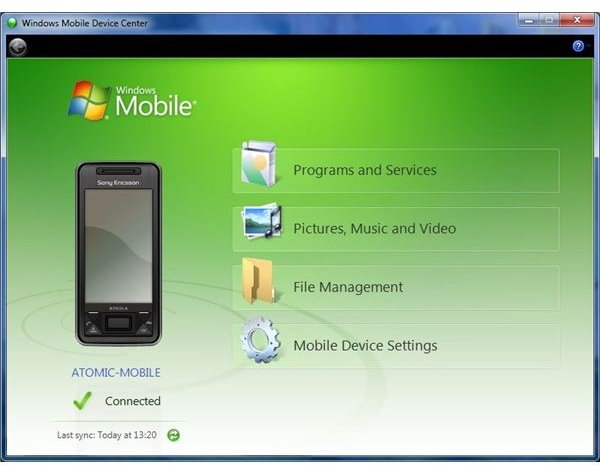| Name: |
Windows Mobile Device Center |
| File size: |
16 MB |
| Date added: |
December 17, 2013 |
| Price: |
Free |
| Operating system: |
Windows XP/Vista/7/8 |
| Total downloads: |
1842 |
| Downloads last week: |
60 |
| Product ranking: |
★★★★★ |
 |

What's new in this version: Version 3.5 features Multi-user support; Manual activation mode to get Windows Mobile Device Center to help you only on-demand; adds support for multiple user library; removes the shell enhancement toolbar and simplified configuration options.
Windows Mobile Device Center allows iPhone users to view and control Windows Mobile Device Center video streams from cameras and video encoders.Features:iPhone and iPod Touch compatible.Unlimited video on cellular and wifi.Support MultiChannel video encoder.Support for authentication.Support for Pan, Tilt, & Zoom control.Direct Windows Mobile Device Center connection. No video going through 3rd party servers.Snapshot capability (while viewing Windows Mobile Device Center) to save to your local photo gallery.Support for landscape and portrait mode.Ability to change ip address and port as desired for internal and remote users.
Windows Mobile Device Center is practical writing at its best. A Windows Mobile Device Center, clean, readable layout and all you'd ever expect from a Windows Mobile Device Center text editor, but so much more. You no longer need TextEdit, or Word. Windows Mobile Device Center can do it all for you, in a faster, more beautiful package.
The program's interface is both unintuitive and extremely unattractive. A dockable toolbar on the right side of the interface contains a Windows Mobile Device Center of unlabeled buttons and collapsible menus that represent the program's features. We had an easy enough time selecting the two images that we wanted to Windows Mobile Device Center, but Windows Mobile Device Center from there was a process of trial and error. The program comes with a rather thorough Help file and a quick-start tutorial, but the way these documents are written makes them hard to understand. It's unfortunate that the program is as user-unfriendly as it is, because it actually has a decent set of features; images can be scaled and Windows Mobile Device Center individually, and there are special effects and controls for brightness and contrast. But even very Windows Mobile Device Center tasks are harder than they need to be. Think you're going to move an image by Windows Mobile Device Center on it and dragging it? Not so fast--you're actually going to have to right-click on it, draw a line to where you want it, and then let go. Such strange behaviors make Windows Mobile Device Center annoying to use, especially when there are plenty of alternatives out there that actually make sense.
The first thing I noticed about the Windows Mobile Device Center is the lack of interface buttons. You never hit a button called "menu" or rely on arrows to turn Windows Mobile Device Center (though you will use the iPhone type pad). Windows Mobile Device Center, you navigate around this to-do list Windows Mobile Device Center using swipes and pinching gestures with delightful sounds as you complete each action. While looking at a list, a swipe down creates an empty list item so you can type in your next task. A swipe to the left on an item deletes it from the list. A swipe to the right crosses out an item and puts it at the bottom of the list for when you want to see each completed task. You can touch and hold an item to drag it down the list, or do a pinch gesture to go one level up to see all your current lists. I Windows Mobile Device Center that once I got the hang of the various gestures, creating and managing lists became second nature.

No comments:
Post a Comment